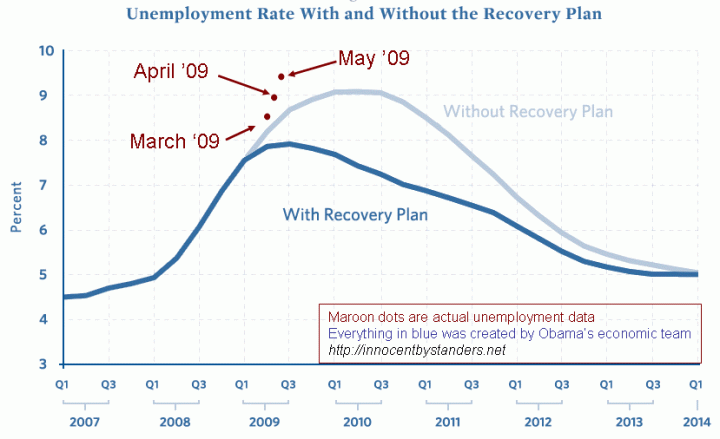Unemployment rose in May to 9.4%. Instead of reporting this as bad news, most mainstream media outlets reported it as positive, because the rate of job losses, they said, is slowing. That’s hardly how it would be reported if a Republican were in the White House! But put that aside. Conservative web sites are showing this graph, produced by Innocent Bystanders, which compares the Obama administration’s projections of what would happen with and without their recovery plan to what has actually happened:

This suggests that either the recovery plan and other administration actions have harmed the economy–which I think is certainly the case in a number of ways, including sowing massive uncertainty–or the administration’s projections are worthless.
But look at that graph carefully. It doesn’t look as if the growth in unemployment is slowing, does it? The mainstream press trumpets, in effect, the second derivative of unemployment. Unemployment rose–the first derivative was positive–but at least the rate of change was negative. Or so they say. The chart, however, shows no decline in the rate of increase in unemployment. The second derivative appears to be slightly above zero. In other words, not only did unemployment increase in May–the rate of increase actually worsened. The mainstream press is just plain wrong.
It’s even worse than the chart suggests. There was a dramatic increase as well in the number of people who aren’t included in the unemployment numbers because they’ve grown discouraged and have stopped looking for work.
So, what’s going on? Among the few people noticing the problem is novanglus, a commenter at the Belmont Club who has some observations:
The headline number of 345k was reduced by some 220k phantom jobs added by the BLS “birth death model”, which is supposed to represent the number of jobs added by the net of starts/ends of small businesses. Now, do any of us really believe that 220k new jobs were created in small businesses in May? I look at our downtown retail area in a mid-sized suburb and see several stores recently closed. Some of these small businesses may be laid off professionals who filed papers for an LLC, so they could eliminate a gap on their resume while they try to find a temporary consulting gig or a new job.
If you look deeper into the numbers reported, they don’t add up. Recall in April, BLS reported:
Nonfarm payroll employment continued to decline in April (-539,000), and the unemployment rate rose from 8.5 to 8.9 percent
Now in May, BLS reports:
Nonfarm payroll employment fell by 345,000 in May, about half the average monthly decline for the prior 6 months, the Bureau of Labor Statistics of the U.S. Department of Labor reported today. The unemployment rate continued to rise, increasing from 8.9 to 9.4 percent.
Let’s think about this qualitatively. If the number of job losses is 64% of those reported in the prior month (lnumerator) and the pool against which they are compared against (denominator) is larger, then shouldn’t the increase in the unemployment rate be smaller too? Yet in April, unemployment went up 0.4% and in May it went up 0.5%. Hmmm. We live in an innumerate world, where people don’t get numbers.
So, dig a little deeper in the May report and they say:
Among the unemployed, the number of job losers and persons who completed temporary jobs rose by 732,000 in May to 9.5 million.
So, what is going on? Am I missing something obvious here?

“This suggests that either the recovery plan and other administration actions have harmed the economy…or the administration’s projections are worthless.”
This is a false dichotomy. Both could be true, and the second is absolutely true.
I’m not sure I get it: did the BLS only net the unemployment rate, counting “Birth/Death” this month, or did B/D spike in May? What are the chances that those folks who went into biz for themselves (but are truly unemployed) are also no longer looking for a job, in which case they are counted as “not not employed” twice?
Is this a blogengine blog? I really like the layout you have, I’d like to start my blog with a similar feel to yours.
Yes, this is a WordPress design, Mistylook, with my own photograph of a pond in New Hampshire.